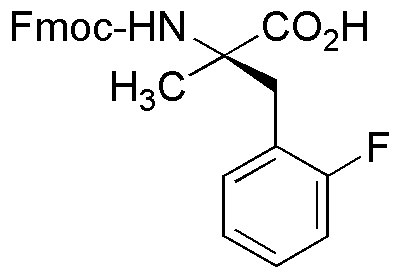Fmoc-a-methyl-D-2-fluorophenylalanine is widely utilized in research focused on:
- Peptide Synthesis: This compound serves as a key building block in the synthesis of peptides, particularly in solid-phase peptide synthesis, enhancing the efficiency and yield of the process.
- Drug Development: It plays a crucial role in the development of novel pharmaceuticals, especially in designing compounds that target specific biological pathways, thanks to its unique structural properties.
- Bioconjugation: The chemical is employed in bioconjugation techniques, allowing researchers to attach biomolecules to surfaces or other compounds, which is essential in creating targeted drug delivery systems.
- Fluorescent Probes: It is used in the creation of fluorescent probes for biological imaging, enabling scientists to visualize cellular processes in real-time, which is invaluable in research and diagnostics.
- Structure-Activity Relationship Studies: This compound aids in studying the relationship between the chemical structure of compounds and their biological activity, providing insights that can lead to more effective therapeutic agents.
Informations générales
Propriétés
Sécurité et réglementation
Applications
Fmoc-a-methyl-D-2-fluorophenylalanine is widely utilized in research focused on:
- Peptide Synthesis: This compound serves as a key building block in the synthesis of peptides, particularly in solid-phase peptide synthesis, enhancing the efficiency and yield of the process.
- Drug Development: It plays a crucial role in the development of novel pharmaceuticals, especially in designing compounds that target specific biological pathways, thanks to its unique structural properties.
- Bioconjugation: The chemical is employed in bioconjugation techniques, allowing researchers to attach biomolecules to surfaces or other compounds, which is essential in creating targeted drug delivery systems.
- Fluorescent Probes: It is used in the creation of fluorescent probes for biological imaging, enabling scientists to visualize cellular processes in real-time, which is invaluable in research and diagnostics.
- Structure-Activity Relationship Studies: This compound aids in studying the relationship between the chemical structure of compounds and their biological activity, providing insights that can lead to more effective therapeutic agents.
Documents
Fiches de données de sécurité (FDS)
La FDS fournit des informations de sécurité complètes sur la manipulation, le stockage et l’élimination du produit.
Spécifications du produit (PS)
Le PS fournit une description complète des propriétés du produit, notamment sa composition chimique, son état physique, sa pureté et les exigences de stockage. Il détaille également les plages de qualité acceptables et les applications prévues du produit.
Certificats d'analyse (COA)
Recherchez des certificats d'analyse (COA) en saisissant le numéro de lot du produit. Les numéros de lot et de lot se trouvent sur l'étiquette d'un produit, après les mots « Lot » ou « Lot de fabrication ».
Numéro de catalogue
Numéro de lot/série
Certificats d'origine (COO)
Ce certificat d'exploitation confirme le pays dans lequel le produit a été fabriqué, et détaille également les matériaux et composants utilisés et s'il est issu de sources naturelles, synthétiques ou autres sources spécifiques. Ce certificat peut être requis pour les douanes, le commerce et la conformité réglementaire.
Numéro de catalogue
Numéro de lot/série
Fiches de données de sécurité (FDS)
La FDS fournit des informations de sécurité complètes sur la manipulation, le stockage et l’élimination du produit.
DownloadSpécifications du produit (PS)
Le PS fournit une description complète des propriétés du produit, notamment sa composition chimique, son état physique, sa pureté et les exigences de stockage. Il détaille également les plages de qualité acceptables et les applications prévues du produit.
DownloadCertificats d'analyse (COA)
Recherchez des certificats d'analyse (COA) en saisissant le numéro de lot du produit. Les numéros de lot et de lot se trouvent sur l'étiquette d'un produit, après les mots « Lot » ou « Lot de fabrication ».
Numéro de catalogue
Numéro de lot/série
Certificats d'origine (COO)
Ce certificat d'exploitation confirme le pays dans lequel le produit a été fabriqué, et détaille également les matériaux et composants utilisés et s'il est issu de sources naturelles, synthétiques ou autres sources spécifiques. Ce certificat peut être requis pour les douanes, le commerce et la conformité réglementaire.


